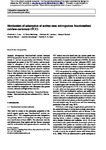Mechanism of adsorption of actives onto microporous functionalised calcium carbonate (FCC)
| dc.contributor.author | Levy, CL | |
| dc.contributor.author | Matthews, Peter | |
| dc.contributor.author | Laudone, Giuliano Maurizio | |
| dc.contributor.author | Beckett, S | |
| dc.contributor.author | Turner, Andrew | |
| dc.contributor.author | Schoelkopf, J | |
| dc.contributor.author | Gane, PAC | |
| dc.date.accessioned | 2017-04-27T17:38:18Z | |
| dc.date.issued | 2017-04-21 | |
| dc.identifier.issn | 1572-8757 | |
| dc.identifier.issn | 1572-8757 | |
| dc.identifier.other | 4 | |
| dc.identifier.uri | http://hdl.handle.net/10026.1/9157 | |
| dc.description.abstract |
Microporous ‘functionalised’ calcium carbonate (FCC) has potential for use as a carrier for the controlled release of ‘actives’, by permeation and diffusion. We have investigated the nature of the FCC surface and the mechanism of adsorption of two typical actives, namely the anti-inflammatory drug aspirin and the flavour compound vanillin, from chloroform and aqueous ethanolic solutions. There is indirect evidence from the quantitative perturbation of Tóth isotherms that their adsorption is hindered by a stagnant diffusion layer of water trapped in the micro-porosity of the FCC. To complement previous studies of the surface of FCC, it was also tested with the cationic probe benzyltrimethylammonium bromide and the anionic probe sodium 2-naphthalenesulphonate. Experimental procedures were validated by comparison with adsorption onto ground calcium carbonate and high surface area talc. | |
| dc.format.extent | 603-612 | |
| dc.language | en | |
| dc.language.iso | en | |
| dc.publisher | Springer Science and Business Media LLC | |
| dc.subject | Controlled drug delivery | |
| dc.subject | Controlled flavour release | |
| dc.subject | Functionalised calcium carbonate (FCC) | |
| dc.subject | Vanillin | |
| dc.subject | Aspirin | |
| dc.title | Mechanism of adsorption of actives onto microporous functionalised calcium carbonate (FCC) | |
| dc.type | journal-article | |
| dc.type | article | |
| plymouth.author-url | https://www.webofscience.com/api/gateway?GWVersion=2&SrcApp=PARTNER_APP&SrcAuth=LinksAMR&KeyUT=WOS:000400185700012&DestLinkType=FullRecord&DestApp=ALL_WOS&UsrCustomerID=11bb513d99f797142bcfeffcc58ea008 | |
| plymouth.issue | 4 | |
| plymouth.volume | 23 | |
| plymouth.publisher-url | http://dx.doi.org/10.1007/s10450-017-9880-7 | |
| plymouth.publication-status | Published | |
| plymouth.journal | Adsorption | |
| dc.identifier.doi | 10.1007/s10450-017-9880-7 | |
| plymouth.organisational-group | /Plymouth | |
| plymouth.organisational-group | /Plymouth/Faculty of Science and Engineering | |
| plymouth.organisational-group | /Plymouth/Faculty of Science and Engineering/School of Geography, Earth and Environmental Sciences | |
| plymouth.organisational-group | /Plymouth/REF 2021 Researchers by UoA | |
| plymouth.organisational-group | /Plymouth/REF 2021 Researchers by UoA/UoA07 Earth Systems and Environmental Sciences | |
| plymouth.organisational-group | /Plymouth/Research Groups | |
| plymouth.organisational-group | /Plymouth/Research Groups/BEACh | |
| plymouth.organisational-group | /Plymouth/Research Groups/Marine Institute | |
| plymouth.organisational-group | /Plymouth/Users by role | |
| plymouth.organisational-group | /Plymouth/Users by role/Academics | |
| dcterms.dateAccepted | 2017-03-07 | |
| dc.rights.embargodate | 2018-4-21 | |
| dc.identifier.eissn | 1572-8757 | |
| dc.rights.embargoperiod | 12 months | |
| rioxxterms.versionofrecord | 10.1007/s10450-017-9880-7 | |
| rioxxterms.licenseref.uri | http://www.rioxx.net/licenses/under-embargo-all-rights-reserved | |
| rioxxterms.licenseref.startdate | 2017-04-21 | |
| rioxxterms.type | Journal Article/Review |


